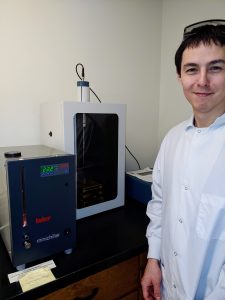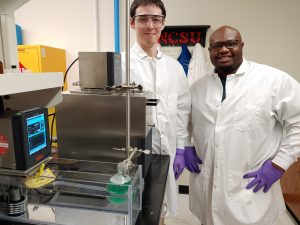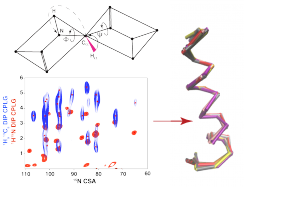01/08/20. Our big thanks to Huber USA for generously donating eight (8) programmable water baths for our macrodisk preparations!
For instance, the 10 L Poly bath has improved our work flow significantly and the Pilot ONE touch screen interface is a pleasure to work with. The addition of the CC-K6s has allowed us improved precision in studying reactions at low temperatures, greatly expanding our capabilities.
The Minichiller 300 makes a simple and economic addition to our probe sonication set up for protein extraction.


01/01/20 CONGRATULATIONS to Joel and Emmanuel for publishing a “Hot Paper” in Angewandte Chemie!
NMR “Crystallography” for Uniformly (13C, 15N)-Labeled Oriented Membrane Proteins
DOI: 10.1002/anie.201915110

Aller guten Dinge sind drei: Strukturelle Angleichung dreier NMR-Winkeleinschränkungen pro Peptidebene (15N CSA, dipolare 1H–15N- und 1Hα—13Cα-Kopplungen) ergeben Rückgradfaltungen orientierter Proteine ohne A-priori-Annahme einer Sekundärstruktur. Eine neue NMR-Sequenz erlaubt die Messung bislang unzugänglicher dipolarer 1Hα—13Cα-Kopplungen und die Berechnung der Transmembranstruktur des Pf1-Hüllenproteins in magnetisch ausgerichteten Bizellen.
NMR-Spektroskopie
Dipolare Kopplungen
Membranproteine
NMR-Spektroskopie
Orientierte Proben
Strukturbestimmung
All good things come in threes: Structural fitting of three NMR angular restraints per peptide plane (15N CSA, 1H–15N and 1Hα—13Cα dipolar couplings) can yield backbone folds of oriented membrane proteins without assuming a secondary structure a^^priori. A new NMR sequence allows to measure the previously inaccessible 1Hα—13Cα dipolar couplings and to calculate the transmembrane structure of Pf1 coat protein in magnetically aligned bicelles.
NMR Spectroscopy
dipolar couplings
membrane proteins
nuclear magnetic resonance
oriented samples
structure determination